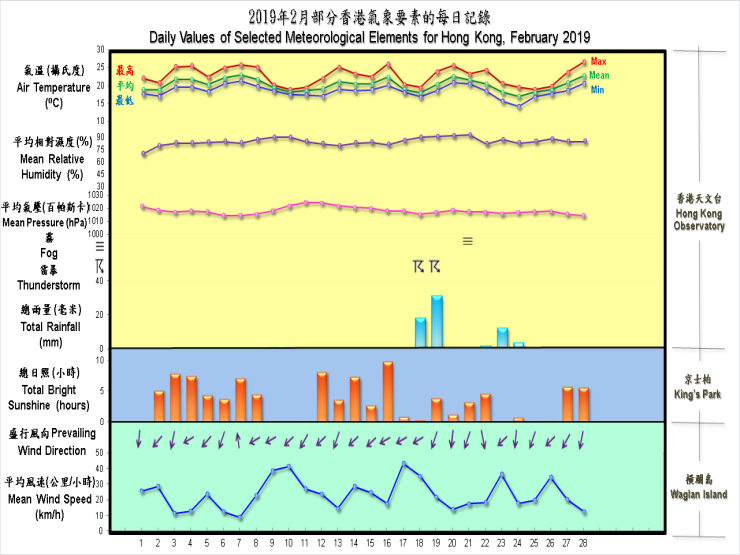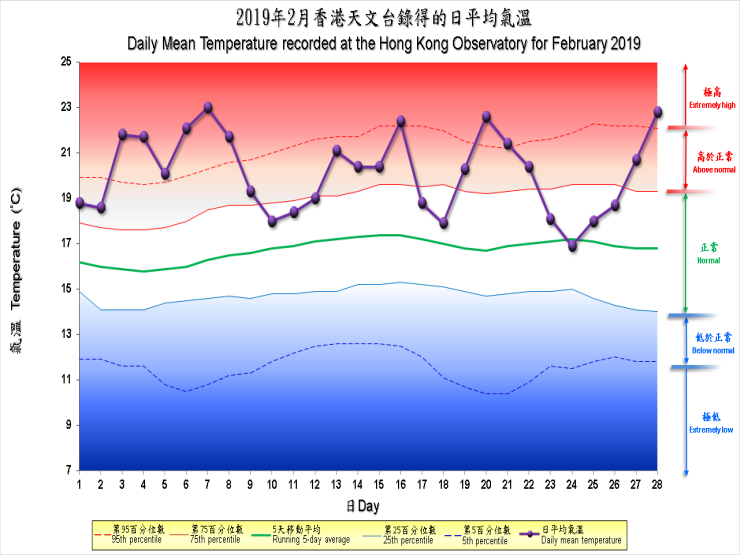The Weather of February 2019
February 2019 was unseasonably warm in Hong Kong which was mainly attributed to weaker than normal northeast monsoon over the south China coast for most of the time in the month. The monthly mean temperature of 20.1 degrees, monthly mean minimum temperature of 18.4 degrees and monthly mean maximum temperature of 22.6 degrees were 3.3 degrees, 3.4 degrees and 3.7 degrees above their corresponding normals and all of them were the second highest on record for February. Together with the well above normal temperatures in December 2018 and January 2019, Hong Kong experienced the warmest winter on record from December 2018 to February 2019 with the winter mean temperature reaching 19.1 degrees, 2.1 degrees above the normal. Moreover, there were only 3 cold days this winter, the fewest on record. February 2019 was also wetter than usual. The monthly rainfall was 68.7 millimetres, about 26 percent above the normal of 54.4 millimetres in February. The accumulated rainfall recorded in the first two months of the year was 73.4 millimetres, a deficit of 7 percent compared to the normal of 78.9 millimetres for the same period.
Under the influence of the northeast monsoon, the weather of Hong Kong was mainly cloudy on the first day of February 2019. With the moderation of the northeast monsoon, local weather improved gradually with sunny periods on the next three days and became warm on 3 and 4 February. Under light wind conditions, there was also coastal fog on the morning of 4 February. Local winds picked up that night when a fresh easterly airstream reached the coast of Guangdong.
With the easterly winds over the coast of Guangdong gradually replaced by a warm maritime airstream, the weather in Hong Kong became warm again with sunny periods and coastal mist on 5 – 8 February. The maximum temperatures recorded at the Observatory rose to 24.9 degrees, 25.8 degrees and 25.1 degrees respectively on 6 – 8 February, making them the warmest second, third and fourth days of the Lunar New Year on record. The mean temperature of the first three days of the Lunar New Year also set a new record high of 21.8 degrees. With a strong northeast monsoon reaching the coast of Guangdong around noon on 8 February, local weather turned cloudy and cooler with a few rain patches in the afternoon and remained so in the following three days.
With the northeast monsoon moderating on 12 February, the weather in Hong Kong became generally fine in that afternoon and the next day. Under the influence of a ridge of high pressure over the coast of southeastern China, local winds strengthened from the east on the night of 13 February. A relatively humid easterly airstream affected the south China coast on 14 - 16 February. There were a few light rain patches in the morning and sunny periods in the afternoon in Hong Kong.
The easterly winds picked up again on 17 February, bringing slightly cooler weather and a few light rain patches to Hong Kong. Under the influence of a trough of low pressure over the coastal areas of Guangdong, there were thundery showers in Hong Kong on 18 and 19 February. The showers were heavy on the morning of 19 February which necessitated the issuance of the first Amber Rainstorm Warning in the year. This was also the second earliest Amber Rainstorm Warning since the rainstorm warning system commenced operation in 1992. More than 30 millimetres of rainfall were recorded over many places of Hong Kong Island, Kowloon and the Islands.
With the return of a warm and humid maritime airstream, the weather of Hong Kong was foggy with sunny intervals on 20 and 21 February. The visibility in the Victoria Harbour fell below 1000 metres on the morning of 21 February. A cold front moved across the coastal areas of Guangdong on the small hours of 22 February. The associated strong northeast monsoon brought cool and rainy weather to Hong Kong on 23 and 24 February. Under the rain, it was rather cool on the morning of 24 February with the temperature at the Observatory dropping to a minimum of 14.1 degrees, the lowest of the month. With the northeast monsoon abating, local weather became brighter with temperatures rising progressively towards the end of the month. The weather was rather warm on 28 February with the maximum temperature at the Observatory soaring to 26.7 degrees in the afternoon, the highest of the month.
One tropical cyclone occurred over the South China Sea and the western North Pacific in the month.
Details of issuance and cancellation of various warnings/signals in the month are summarized in Tables 1.1 to 1.3. Monthly meteorological figures and departures from normal for February are tabulated in Table 2.
Warnings and Signals issued in February 2019
| Beginning Time | Ending Time | ||
|---|---|---|---|
| Day/Month | HKT | Day/Month | HKT |
| 9 / 2 | 1030 | 10 / 2 | 1610 |
| 17 / 2 | 1145 | 18 / 2 | 1440 |
| 23 / 2 | 0745 | 23 / 2 | 2040 |
| Colour | Beginning Time | Ending Time | ||
|---|---|---|---|---|
| Day/Month | HKT | Day/Month | HKT | |
| Amber | 19 / 2 | 0900 | 19 / 2 | 1010 |
| Beginning Time | Ending Time | ||
|---|---|---|---|
| Day/Month | HKT | Day/Month | HKT |
| 18 / 2 | 1400 | 18 / 2 | 1600 |
| 19 / 2 | 0615 | 19 / 2 | 1230 |
| Meteorological Element | Figure of the Month | Departure from Normal* |
|---|---|---|
| Mean Daily Maximum Air Temperature | 22.6 degrees C | 3.7 degrees above normal |
| Mean Air Temperature | 20.1 degrees C | 3.3 degrees above normal |
| Mean Daily Minimum Air Temperature | 18.4 degrees C | 3.4 degrees above normal |
| Mean Dew Point Temperature | 17.5 degrees C | 4.5 degrees above normal |
| Mean Relative Humidity | 85 % | 5 % above normal |
| Mean Cloud Amount | 82 % | 8 % above normal |
| Total Rainfall | 68.7 mm | 14.3 mm above normal |
| Number of hours of Reduced VisibilityΔ | 21 hours | 106.6 hours below normal§ |
| Total Bright Sunshine Duration | 96.9 hours | 2.7 hours above normal |
| Mean Daily Global Solar Radiation | 10.63 Megajoule / square metre | 1.24 Megajoule above normal |
| Total Evaporation | 55.8 mm | 4.1 mm below normal |
| Remarks : | All measurements were made at the Hong Kong Observatory except sunshine,
solar radiation and evaporation which were recorded at King's Park
Meteorological Station and visibility which was observed at the Hong
Kong International Airport. |
| Δ | The visibility readings at the Hong Kong International Airport are based on hourly observations by professional meteorological observers in 2004 and before, and average readings over the 10-minute period before the clock hour of the visibility meter near the middle of the south runway from 2005 onwards. The change of the data source in 2005 is an improvement of the visibility assessment using instrumented observations following the international trend.
|
* Departure from 1981 - 2010 climatological normal, except for number of hours of reduced visibility |
|
§ Departure from mean value between 1997 and 2018 |
|


| Remarks : | Extremely high: above 95th percentile Above normal: between 75th and 95th percentile Normal: between 25th and 75th percentile Below normal: between 5th and 25th percentile Extremely low: below 5th percentile Percentile and 5-day running average values are computed based on the data from 1981 to 2010 |
